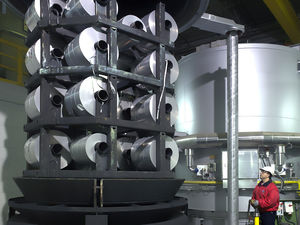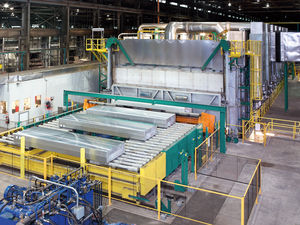

- Products
- Catalogs
- News & Trends
- Exhibitions
Chamber furnace HICON heat treatmentbatchfor aluminum







Add to favorites
Compare this product
Characteristics
- Configuration
- chamber
- Function
- heat treatment
- Other characteristics
- batch, for aluminum
Description
The main criterion here is whether the material is to be annealed in air or process atmosphere. All alloys that tend to discolor due to the formation of manganese oxide (like alloy AA 3004, for example) have to be annealed in process atmosphere.
The same applies to all other alloys where the thinnest possible layer of oxide is required (e.g. to extend the service life of deep drawing dies), and also to clad strip (e.g. for manufacturing car radiators).
The HICON batch-type furnace reduces temperature scatter to a minimum throughout the entire charge, even as it keeps heating-up times as short as possible (e.g. for anneal to temper: Δt less than ± 3 °C at the end of soaking). The gas-tight design of the batch furnace enables trace oxygen contents of less than 0.05 %v/v.
Foil coils are processed with a special annealing program that allows the rolling lubricant to evaporate without trace so that sticking is prevented and the necessary surface cleanliness is guaranteed. Anneals in process atmosphere provide the advantage that the necessary surface cleanliness is achieved in the shortest time because the atmosphere promotes evaporation of the rolling lubricant, reducing the risk of the oil cracking on the foil surface.
HICON batch-type furnaces are distinguished by the following features:
Rapid, even temperature distribution across the strip coil, due to the symmetrical arrangement of the jet nozzle system
Clean coil surface due to oxygen-free workload space provided by the tightly-sealed furnace design
Optimized and sealed central atmosphere cooling system to quickly cool coils in the furnace
Related Searches
- Furnace
- Chamber furnace
- Electric furnace
- Heat treatment furnace
- Drying furnace
- Laboratory furnace
- Combustion furnace
- Gas furnace
- Tunnel furnace
- Industrial furnace
- Controlled atmosphere furnace
- High-temperature furnace
- Automatic furnace
- Vacuum furnace
- Continuous furnace
- Annealing furnace
- Forced convection furnace
- Thermal furnace
- Horizontal furnace
- Quenching furnace
*Prices are pre-tax. They exclude delivery charges and customs duties and do not include additional charges for installation or activation options. Prices are indicative only and may vary by country, with changes to the cost of raw materials and exchange rates.











